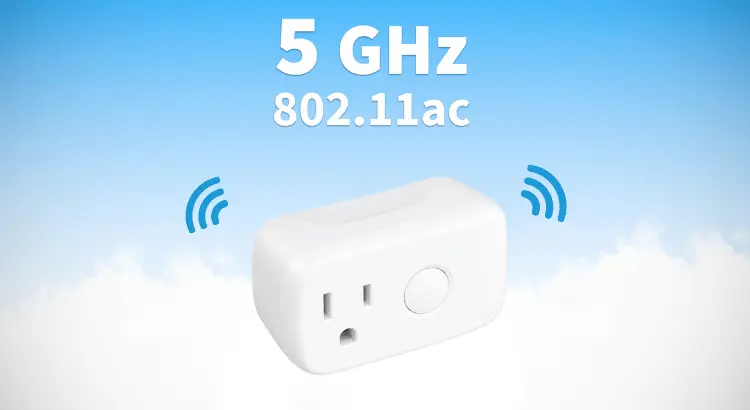DISCLOSURE: THIS POST MAY CONTAIN AFFILIATE LINKS, MEANING I GET A COMMISSION IF YOU DECIDE TO MAKE A PURCHASE THROUGH MY LINKS, AT NO COST TO YOU. PLEASE READ MY DISCLOSURE FOR MORE INFO.
5GHz Wi-Fi is highly sought-after in today’s fast-paced world, as people constantly search for quicker and more reliable internet connections. The increasing demand for high-speed internet is fueled by the numerous devices and applications that necessitate robust connectivity.
While most high-speed Wi-Fi connections operate at 5 GHz and 6 GHz Wi-Fi, most people and electronic devices still use a 2.4 GHz Wi-Fi connection for various reasons.
One of these reasons is that many smart plugs currently available in the market only support a 2.4 GHz connection, rather than the faster 5 GHz one.
But if you’re someone who values lightning-fast internet speeds above all else, don’t worry, there are smart plugs out there that support a 5 GHz Wi-Fi connection.
What is a Smart Plug and How Can It Make Your Life Easier?

Smart plugs are cool little gadgets that you can plug into your regular wall outlets. They basically make your ordinary appliances, like lamps, fans, or coffee makers, way smarter!
Once you plug an appliance into a smart plug, you can control that appliance using your smartphone, tablet, or even your voice if you have a smart speaker like Amazon Echo, Google Home, or Apple Homepod.
One of the coolest things about smart plugs is that they let you turn your devices on and off from anywhere, as long as you have an internet connection.
You can also create schedules, so your devices automatically turn on or off at certain times. Imagine waking up to a freshly brewed coffee every morning or having your lights turn on just before you get home!
Some smart plugs even help you track how much energy your devices are using. This can help you save money on your energy bills and make your home more eco-friendly.
Smart plugs are available for both indoor and outdoor use. Whether you need an indoor or outdoor smart plug, these versatile devices can make controlling and scheduling your appliances a breeze, adding convenience and energy efficiency to your life.
Why Choose 5GHz Wi-Fi Smart Plugs?
5GHz Wi-Fi smart plugs are a popular choice among smart home enthusiasts due to their numerous advantages over traditional 2.4GHz Wi-Fi smart plugs. Some of the benefits include:
They offer faster data transfer speeds compared to the 2.4GHz ones. This means controlling your smart devices feels smooth and practically instant. Who doesn’t love that lightning-fast response?
Next, we have the amazing perk of less interference. Since the 5GHz frequency band isn’t as crowded as the 2.4GHz, your smart plug’s connection will be more stable and reliable. No more worrying about your Wi-Fi getting all tangled up with other wireless devices in your home!
And finally, 5GHz Wi-Fi smart plugs come with a wider bandwidth. That means they can handle more devices on your network without slowing everything down. This is super handy if you have lots of smart gadgets at home that all need to be connected at the same time.
What You Need to Know About 2.4GHz and 5GHz Wi-Fi Connections
If you’re feeling uncertain about which Wi-Fi connection to choose, here are some factors that can help you make a more informed decision.
Speed and Range
One of the biggest differences between the two frequencies is their speed and range. Generally speaking, 5GHz Wi-Fi is faster than 2.4GHz Wi-Fi but has a shorter range. So, if you have a larger home or plan to use your Wi-Fi outside, 2.4GHz may be the better choice. But if you prioritize speed and have a smaller living space, 5GHz is the way to go.
Device Compatibility
Another important factor to consider is your device compatibility. While most modern devices can connect to both 2.4GHz and 5GHz Wi-Fi, some older devices may only support one or the other. So, if you have older smart home gadgets or devices that only support 2.4GHz Wi-Fi, you’ll need to stick with that frequency.
Interference
Interference can also play a role in your Wi-Fi connection quality. 2.4GHz Wi-Fi is more susceptible to interference from other devices that use the same frequency, such as baby monitors or microwaves. 5GHz Wi-Fi, on the other hand, experiences less interference due to its higher frequency. So, if you have a lot of other wireless devices in your home, 5GHz may be the better choice for a more reliable connection.
Frequency Bandwidth
The frequency bandwidth of 5GHz Wi-Fi is wider than that of 2.4GHz Wi-Fi, which means it can support more devices at once. If you have a lot of smart home gadgets and devices that need to connect to Wi-Fi, 5GHz may be the better choice to avoid overloading your network.
I Noticed My Router Mentions “5GHz”: Can I Still Use 2.4GHz Smart Plugs With it?
The good news is that most modern routers are actually dual-band routers. This means they can support both 2.4GHz and 5GHz Wi-Fi frequencies at the same time.
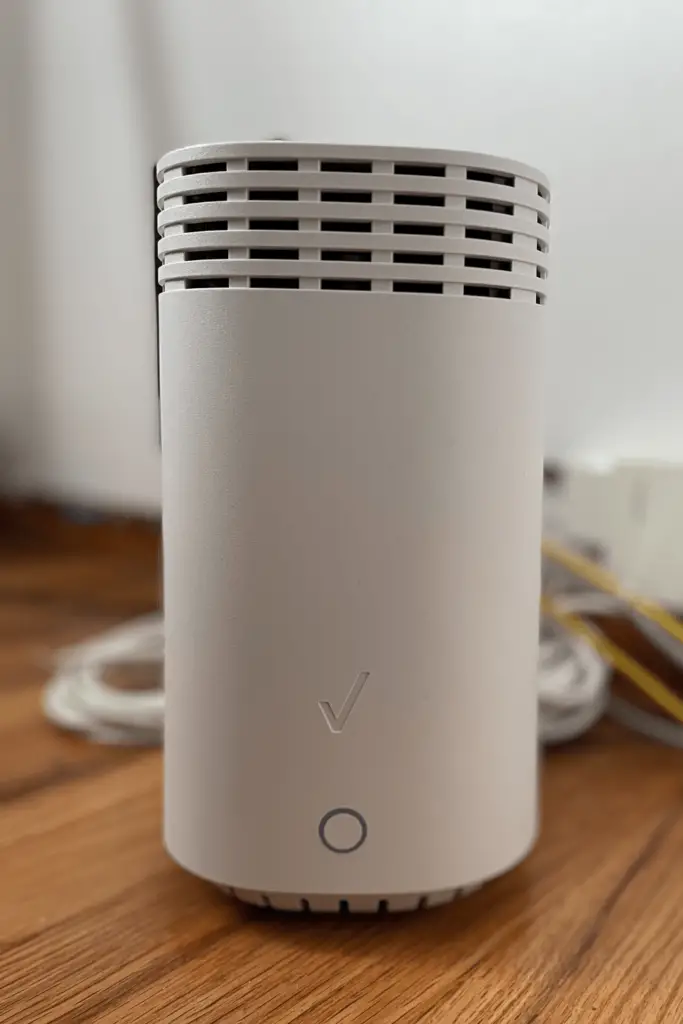
So, even if your router says it’s “5GHz,” it’s very likely that it’s also running a 2.4GHz network for your devices to connect to.
Similar to the Ring Pro, numerous contemporary routers are dual-band routers, meaning they can simultaneously manage connections on both the 2.4GHz and 5GHz frequencies.
To make sure, you can check your router’s settings or look in the user manual to see if it supports dual-band operation. If it does, then your 2.4GHz smart plugs should work just fine!
Just remember that when you’re setting up your smart plugs, you’ll need to connect them to the 2.4GHz network, as most smart plugs don’t support the 5GHz frequency.
Once you’ve got them connected, you’ll be all set to enjoy your smart home gadgets!
Smart Plugs that Support 5 GHz Wi-Fi
The vast majority of smart plugs on the market support only the 2.4GHz Wi-Fi frequency. This is primarily because 2.4GHz provides a better range and can penetrate walls and other obstacles more effectively than 5GHz, making it ideal for smart home devices.
While it’s rare to find smart plugs specifically designed for 5GHz, you might come across some dual-band smart plugs that can operate on both 2.4GHz and 5GHz frequencies.
These are relatively uncommon, and their availability may vary based on your location or the specific brand.
Keep in mind that even if a smart plug supports 5GHz, it may still prioritize the 2.4GHz frequency for the reasons mentioned above.
However, since the 5-GHz Wi-Fi band is still emerging, there are currently two smart plugs available that support it.
ExIoTy Smart Plug
The ExIoTy Smart plug is a compact and easy-to-use gadget that connects to your home’s Wi-Fi network and lets you manage your devices through a user-friendly app on your smartphone or tablet.
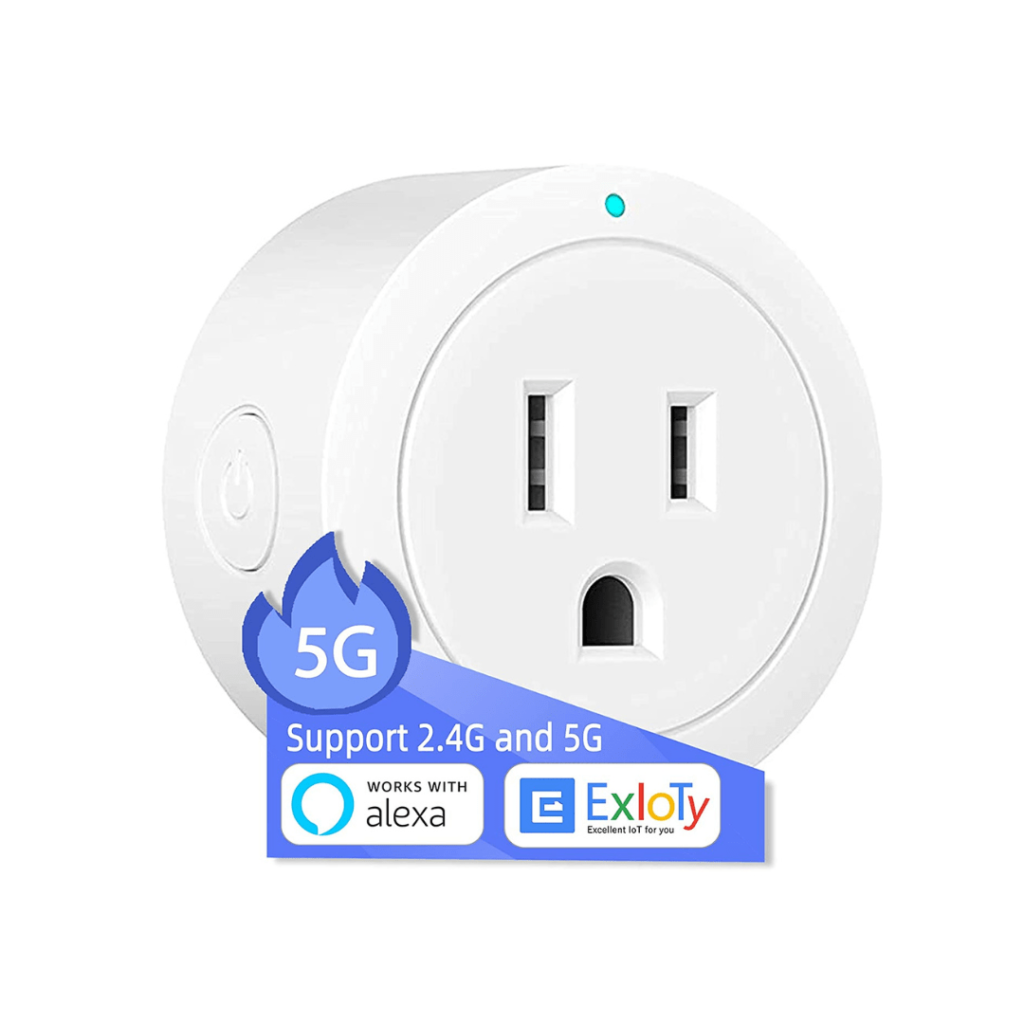
Just plug it into an electrical outlet, connect your device (like a lamp, fan, or coffee maker), and voilà – you now have smart control over it. You can turn it on/off, set schedules, and even monitor energy consumption, all from the comfort of your couch or even when you’re away from home.
The ExIoTy Smart Plug primarily supports the 2.4GHz Wi-Fi frequency, which is the most common and widely used frequency for smart home devices. This is because 2.4GHz provides a better range and is more capable of penetrating walls and other obstructions compared to 5GHz.
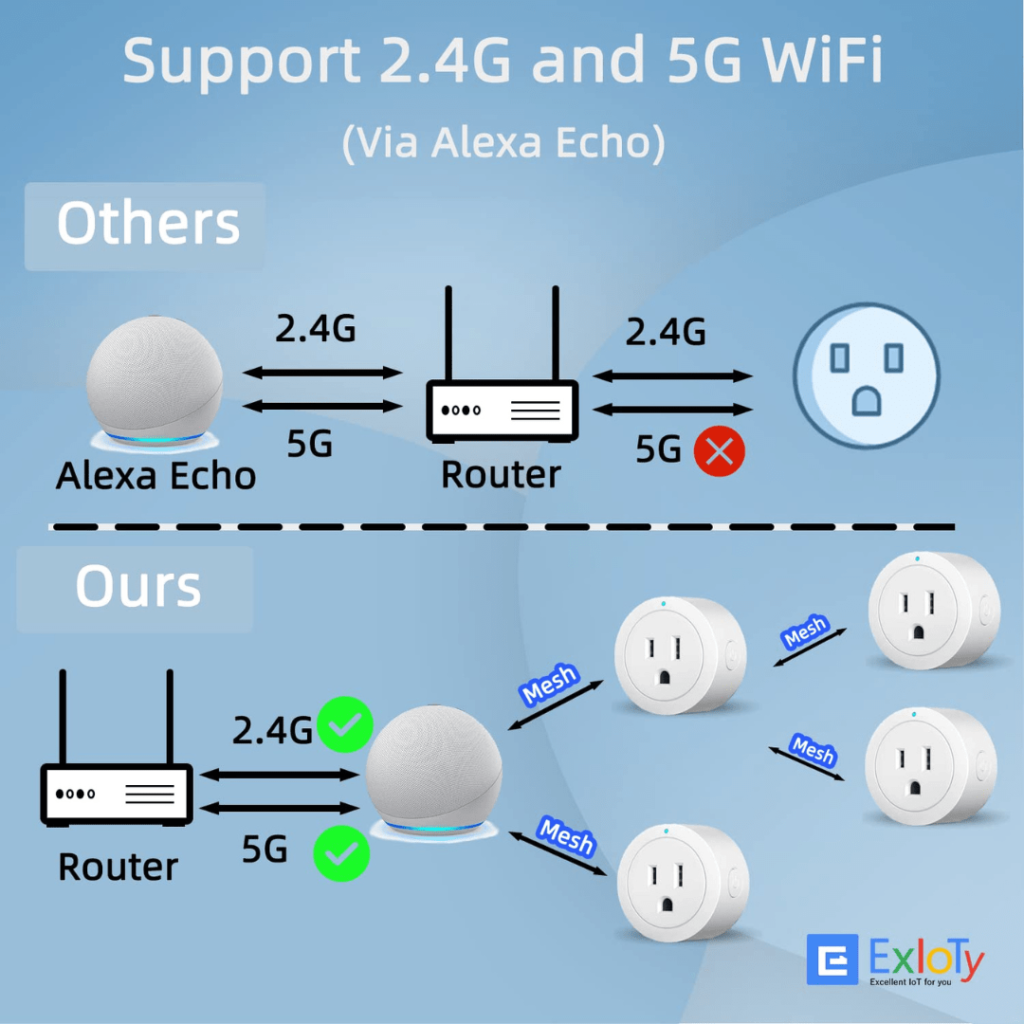
However, if your router is a dual-band router that supports both 2.4GHz and 5GHz frequencies, you can still use the ExIoTy Smart Plug. What happens is that your router will automatically assign devices to the appropriate frequency.
Since the ExIoTy Smart Plug is designed for 2.4GHz, it will connect to the 2.4GHz frequency while other devices that support 5GHz will connect to that frequency.
ExIoTy sale page mention working with “Amazon Alexa” as its primary voice assistant, but It is designed to be compatible with multiple voice assistants, which makes it a versatile choice for your smart home setup.
Besides Amazon Alexa, the smart plug also works with Google Assistant, allowing you to control your devices with voice commands through either of these popular platforms.
To use it with your preferred voice assistant, you’ll need to connect the ExIoTy Smart Plug to the respective app (Amazon Alexa or Google Home) and follow the setup instructions.
Once it’s configured, you can enjoy hands-free control of your connected devices simply by asking your voice assistant to turn them on or off, or even set routines and schedules.
BroadLink Smart Plug
The BroadLink Smart Plug enables you to control your home appliances remotely using a smartphone app or voice assistant like Amazon Alexa or Google Assistant.
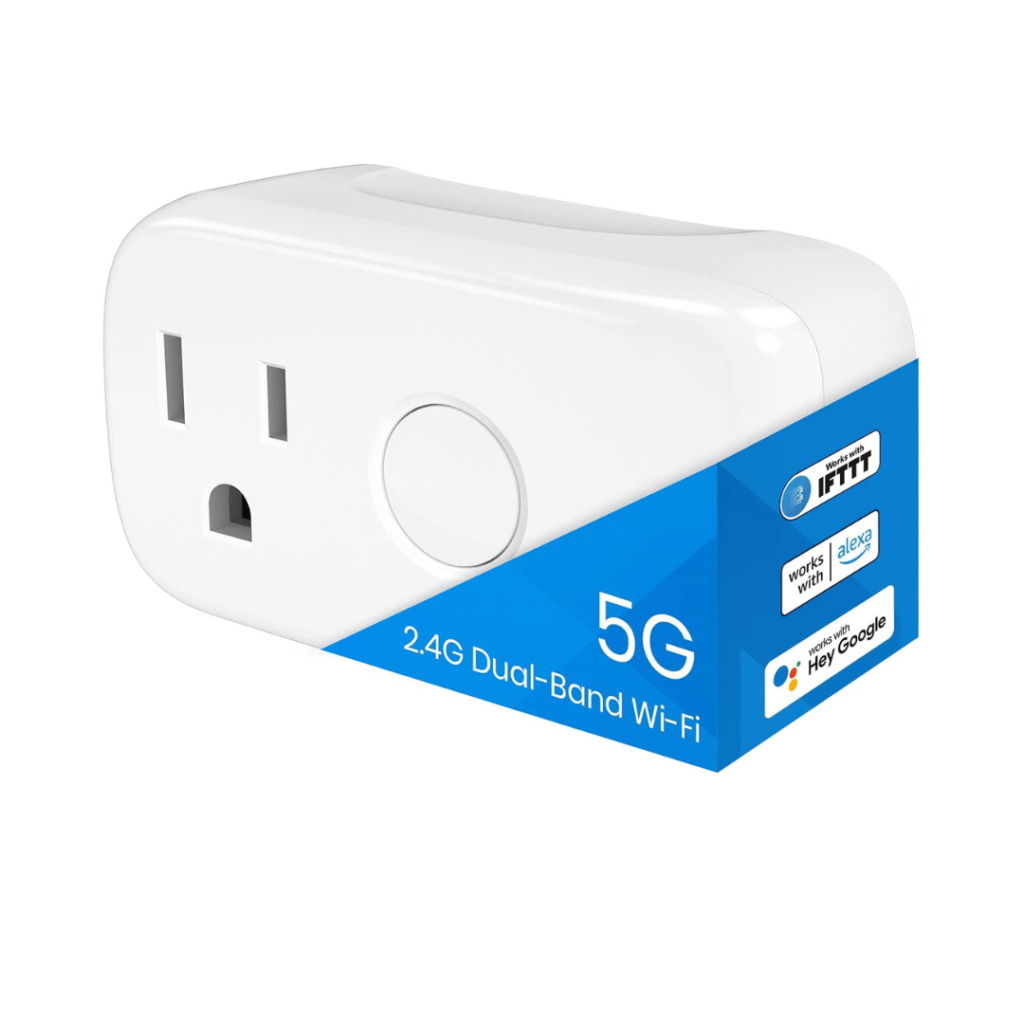
One of the unique features of the BroadLink Smart Plug is its energy monitoring capabilities. This means that you can track how much energy your appliances are using and adjust your usage accordingly to save on your electricity bill.
The BroadLink Smart Plug supports 2.4GHz Wi-Fi networks, which is the most commonly used frequency band for smart home devices.
But, the manufacturer claims that the plug is also compatible with 5GHz networks, which could provide faster data transfer speeds. The packaging also states it supports both 2.4-GHz and 5-GHz Wi-Fi networks.

Some users have reported issues with the app not detecting their 5GHz Wi-Fi network. This could be a drawback for those looking for faster data transfer speeds or for those with a large number of devices on their 2.4GHz network.
With the uncertainty about the quality of the 5-GHz, you may want to consider other options or look on Amazon for updated reviews.
In the meantime, If you are looking for a smart plug that works with 5GHz Wi-Fi, I recommend checking the manufacturer’s specifications for the latest models or contacting customer support to confirm compatibility before making a purchase.
As soon as I discover additional information, I’ll make sure to update this page.
However, if you come across any new findings, please feel free to reach out to me, so I can include them here with my appreciation.
Factors to Consider When Choosing a 5GHz Wi-Fi Smart Plug
When selecting the perfect 5GHz Wi-Fi smart plug for your needs, consider the following factors:
- Compatibility: Ensure the smart plug is compatible with your existing smart home ecosystem, such as Amazon Alexa, Google Assistant, or Apple HomeKit.
- Design: Opt for a compact design to prevent blocking adjacent outlets and allow for multiple plugs in a single outlet.
- Ease of Setup: Choose a smart plug that’s easy to install and doesn’t require a separate hub for operation.
- Energy Monitoring: Consider a smart plug with energy monitoring capabilities to help you track and optimize your energy consumption.
- Reliability and Security: Look for a smart plug from a reputable brand with robust encryption to ensure a secure connection and reliable performance.
How to Convert a Device Connected to 5GHz Wi-Fi to 2.4GHz Wi-Fi?
If you have a device that’s connected to a 5GHz Wi-Fi network but you need to switch it to a 2.4GHz network, there are a few steps you can follow:
- Check your device’s manual or specifications to see if it’s compatible with 2.4GHz Wi-Fi. Not all devices can connect to both 2.4GHz and 5GHz networks.
- Log in to your router’s settings page on a web browser. The address for this page can usually be found in the router’s manual or at the bottom of the router itself.
- Look for the option to change the Wi-Fi network’s frequency band. This option may be located in the wireless settings section of the router’s settings page.
- Select the 2.4GHz frequency band and save the changes. This will switch your Wi-Fi network to the 2.4GHz band.
- On your device, disconnect from the 5GHz Wi-Fi network and connect to the newly created 2.4GHz network. Your device should now be connected to the 2.4GHz network instead of the 5GHz one.
Frequently Asked Questions
Can I use a 5GHz Wi-Fi smart plug with a 2.4GHz Wi-Fi network?
Some 5GHz Wi-Fi smart plugs are dual-band, meaning they can work with both 5GHz and 2.4GHz Wi-Fi networks. Check the smart plug’s specifications to ensure compatibility with your Wi-Fi network.
Do 5GHz Wi-Fi smart plugs require a separate hub?
Most 5GHz Wi-Fi smart plugs do not require a separate hub for operation. They can be controlled using their corresponding app or through a voice assistant.
Can I use a 5GHz Wi-Fi smart plug outdoors?
While some smart plugs are designed for outdoor use, it’s important to check the specifications of the specific 5GHz Wi-Fi smart plug you’re considering. Look for a smart plug with weatherproof features, such as a durable casing and a high IP rating, to ensure it can withstand outdoor conditions.
Can I control a 5GHz Wi-Fi smart plug when I'm away from home?
Yes, you can control your 5GHz Wi-Fi smart plug remotely via its corresponding app, as long as you have an active internet connection. This allows you to turn devices on or off, monitor energy consumption, and set schedules even when you’re not at home.
How can I ensure the best performance for my 5GHz Wi-Fi smart plug?
To ensure optimal performance of your 5GHz Wi-Fi smart plug, follow these tips:
- Place your Wi-Fi router in a central location to provide a strong and stable connection.
- Regularly update your smart plug’s firmware to benefit from the latest improvements and bug fixes.
- Avoid placing your Wi-Fi router near sources of interference, such as microwaves, cordless phones, or other wireless devices.
Final Note
Smart plugs, like the ExIoTy Smart Plug and BroadLink Smart Plugs, are incredibly useful devices for transforming regular appliances into smart, connected ones.
While most smart plugs primarily support the 2.4GHz Wi-Fi frequency for better range and wall penetration, finding one that supports 5GHz remains rare.
Regardless, these smart plugs provide users with convenience and flexibility by integrating with popular voice assistants like Amazon Alexa and Google Assistant.
As the smart home industry continues to evolve, it’s essential to stay updated on the latest products and their compatibility to create the best possible connected living experience.
Make sure to check out our top gadget recommendations to get the best value for your money. For more tips and tricks on home automation, be sure to visit AutomateYourCrib.com.
If you have any feedback, ideas, or suggestions for future posts, feel free to reach out to me at rodney@automateyourcrib.com.
Thank you for taking the time to read this post. Until next time, have a great time automating!
It's great to see that you have come across my website. I hope you explore it thoroughly. The website caters to regular consumers who have an interest in home automation. I am based in the Tri-state area and enjoy the latest smart tech along with my wonderful wife and three energetic boys.

